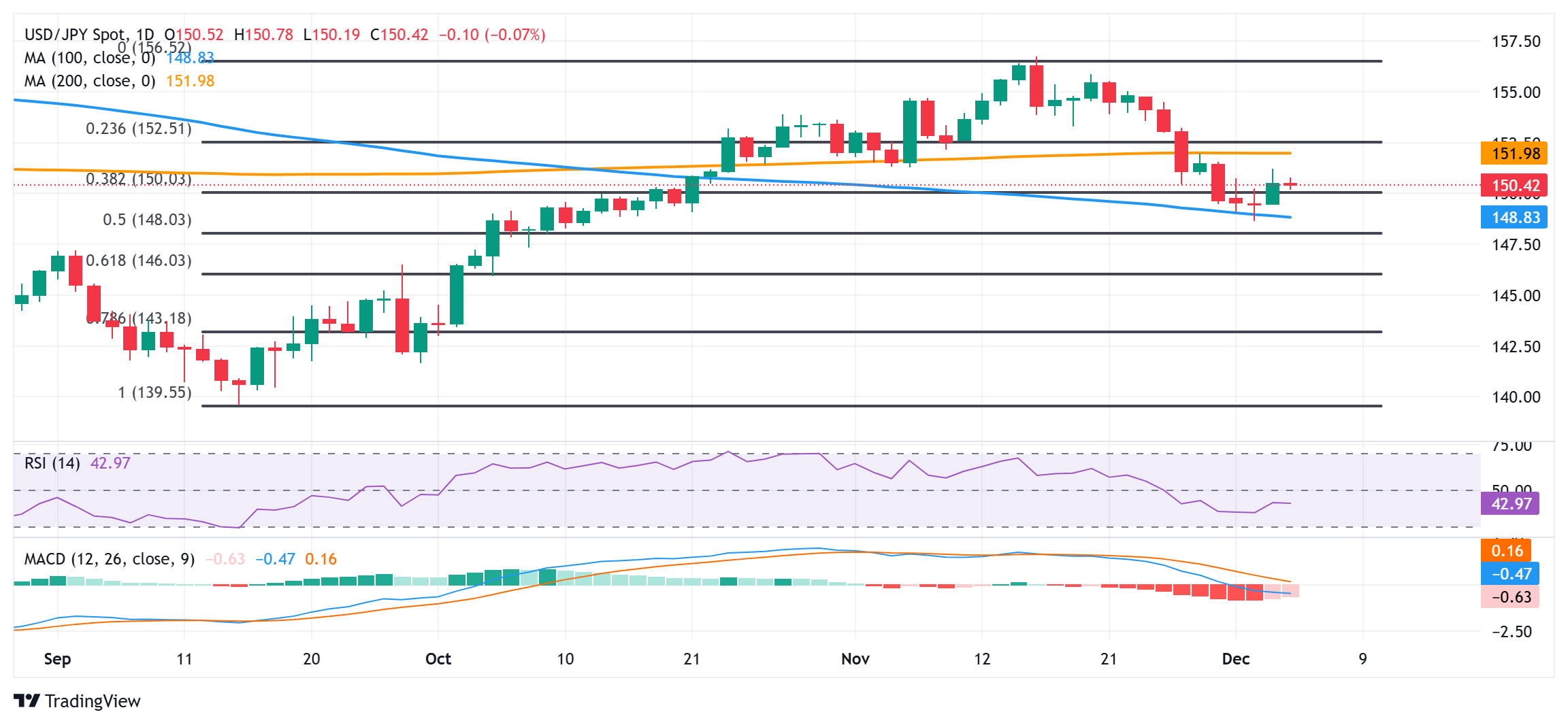- The Japanese Yen attracts some buyers on Thursday, although it lacks bullish conviction.
- The rebound in US bond yields underpins the USD and offers support to the USD/JPY pair.
- Traders appear reluctant to place aggressive bets ahead of Friday’s US NFP report.
The Japanese Yen (JPY) rises against its US counterpart during the Asian session on Thursday and moves away from the weekly low touched the previous day. Signs that core inflation in Japan is gaining momentum continue to fuel expectations that the Bank of Japan (BoJ) will raise interest rates again in December. Furthermore, lingering geopolitical risks, trade war fears and overnight decline in US Treasury yields further benefit the lower-yielding JPY.
That said, hawkish comments from a number of influential FOMC members, including Federal Reserve (Fed) Chairman Jerome Powell, act as a tailwind for US bond yields and the US Dollar (USD). ). This, coupled with the prevailing risk environment, could keep any significant appreciation in the safe-haven JPY at bay and lend some support to the USD/JPY pair. Traders could also refrain from making aggressive directional bets ahead of Friday’s US Nonfarm Payrolls (NFP) report.
Japanese Yen Finds Some Support on BoJ Rate Hike Expectations in December
- A stronger Tokyo Consumer Price Index for November and hawkish comments from Bank of Japan Governor Kazuo Ueda last week raised expectations of another rate hike in December.
- Toyoaki Nakamura, a BoJ board member, said he is unsure about the sustainability of wage growth and sees a chance that inflation will not reach 2% from fiscal 2025.
- Russian Deputy Foreign Minister Sergei Ryabkov warned that Russia could escalate its military actions in Ukraine if the US and its allies do not recognize its limits.
- Investors remain concerned that US President-elect Donald Trump’s tariff plans will trigger the second wave of global trade wars and their effects on the global economy.
- The Institute for Supply Management’s (ISM) services Purchasing Managers’ Index (PMI) fell to a three-month low of 52.1 in November, from 56.0 the previous month, missing estimates.
- The benchmark 10-year U.S. Treasury yield fell on Wednesday to its lowest closing level since Oct. 21, although the decline remains limited.
- The Federal Reserve’s Beige Book on Wednesday showed that economic activity rose slightly in November as businesses became more optimistic about the demand outlook.
- St. Louis Fed President Alberto Musalem said it might be possible to pause rate cuts at upcoming meetings, but they are keeping all options open for the December meeting.
- Fed Chair Jerome Powell said the U.S. central bank may take a slightly more cautious approach in cutting interest rates toward a neutral level as the economy remains in good shape.
- San Francisco Fed President Mary Daly reiterated that the central bank does not need to be urgent in rate cuts and that there is much more work to do to achieve 2% inflation.
- This, coupled with speculation that Trump’s policies will reignite inflation, triggers a slight rally in US bond yields and acts as a tailwind for the US dollar.
- Traders now await the release of the usual US initial jobless claims. However, attention remains focused on Friday’s US Non-Farm Payrolls (NFP) report.
USD/JPY will likely face a strong barrier and remain capped near 152.00
From a technical perspective, the USD/JPY pair showed resilience below the 100-day SMA earlier this week and the subsequent recovery from its lowest level since October 11 supports prospects for further gains . That said, the oscillators on the daily chart remain in negative territory and are still far from being in the oversold zone. This, in turn, suggests that any further movement beyond the overnight intraday high, around the 151.20-151.25 region, will likely remain capped near the 152.00 level. The latter coincides with the very important 200-day SMA and should act as a key point. Sustained strength beyond will suggest that the recent downward correction from a multi-month high hit in November has come to an end and will shift the bias in favor of bullish traders.
On the other hand, weakness below the psychological level of 150.00 seems to find decent support near the horizontal zone of 149.55-149.50. The next relevant support lies near the 149.00 level ahead of the 100-day SMA, currently around the 148.80 region. A sustained break and acceptance below the latter will be considered a new trigger for bearish traders and will drag the USD/JPY pair to the 148.10-148.00 region en route towards the 147.35-147.30 zone and the round figure of 147.00.
The Japanese Yen FAQs
The Japanese Yen (JPY) is one of the most traded currencies in the world. Its value is determined broadly by the performance of the Japanese economy, but more specifically by the policy of the Bank of Japan, the differential between the yields of Japanese and US bonds or the risk sentiment among traders, among other factors.
One of the mandates of the Bank of Japan is currency control, so its movements are key for the Yen. The BoJ has intervened directly in currency markets on occasion, usually to lower the value of the Yen, although it often refrains from doing so due to the political concerns of its major trading partners. The BoJ’s current ultra-loose monetary policy, based on massive stimulus to the economy, has caused the depreciation of the Yen against its main currency pairs. This process has been exacerbated more recently by a growing policy divergence between the Bank of Japan and other major central banks, which have opted to sharply raise interest rates to combat decades-old levels of inflation.
The Bank of Japan’s ultra-loose monetary policy stance has led to increased policy divergence with other central banks, particularly the US Federal Reserve. This favors the widening of the spread between US and Japanese 10-year bonds, which favors the Dollar against the Yen.
The Japanese Yen is often considered a safe haven investment. This means that in times of market stress, investors are more likely to put their money in the Japanese currency due to its supposed reliability and stability. In turbulent times, the Yen is likely to appreciate against other currencies that are considered riskier to invest in.
Source: Fx Street
I am Joshua Winder, a senior-level journalist and editor at World Stock Market. I specialize in covering news related to the stock market and economic trends. With more than 8 years of experience in this field, I have become an expert in financial reporting.








